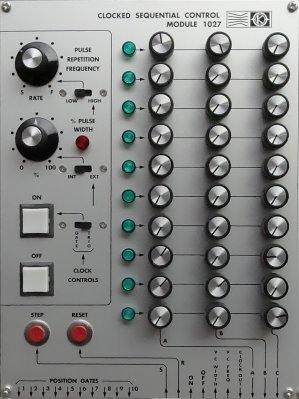
1027
Sequencer
The MOS-LAB 1027 Ten-Position Sequencer is a compact sequential voltage generator used for controlling oscillators, filters, amplifiers, and other modules. The 1027 Sequencer contains a ten-step counter and three rows of dial knobs to provide three independently adjustable virtual voltage outputs for each sted of the counter. In addition, a built-in time base generator allows the sequencer to step along automatically. A variety of inputs, outputs, and panel controls facilitates the execution of complex sequencing patterns, rhythmic patterns, and external control. When used at switching rates in the audio spectrum, the sequencer can generate complex waveforms by stepwise approximations.
The three voltage outputs A, B, and C, are shown on the panel with their associated column of potentiometers. Each row of three potentiometers is adjacent to an indicator light wich displays the sequencer count, and hence the three potentiometers wich are active.
Illuminated push button switches are used to start and stop the internal clock. A control labeled «pulse repetition frequency» adjusts the stepping rate of the sequencer from 20 per minute to 400 per second in two ranges. In addition, the clock frequency can be controlled from an external source ; an input to the sequencer labeled «VC freq» is provided for this purpose. The external control voltage is added internally to the voltage generated by the front panel «rate» control.
The internal clock can be turned on and off by applying pulses to the «on» and «off» inputs.
The sequencer produces a 10 volt gate pulse every time the sequencer steps to a new position. The width of this pulse, normally used for controlling envelope generators, amplifiers, filters, etc., is controlled from the front panel or from an external voltage and can vary from ∼5% to ∼95% of the period between steps.
With the clock turned off, the sequencer may be stepped along and reset manually using the front panel push buttons. An external voltage applied to the ”S” and ”R” inputs will step the sequencer and reset it. Complex sequential patterns are generated using the ”S” and ”R” inputs and the ”Position Gates”.
Connecting the ”R” input of the sequencer to a ”Position Gate” output will cause the sequencer to reset when the sequencer reaches that position.
Similarly, the ”S” input can be connected to any ”Position Gates” to cause the sequencer to skip those positions.
ELECTRICAL SPECIFICATIONS :
OUTPUT IMPEDANCES : 1Kohm all outputs.
OUTPUT IMPEDANCES : 100Kohms minimum, all inputs.
INPUT SENSITIVITY :
”S”, ”R”, ”ON”, ”OFF” inputs, +8 Volts
”V.C Width”, ”V.C freq” inputs, 0-10 Volts
PULSE REPETITION FREQUENCY : 20 pulses/minute to 400 pulses/second, without external control.




